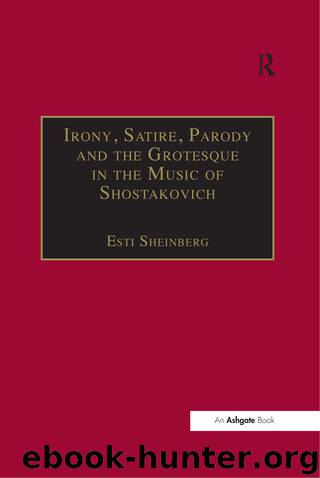Irony, Satire, Parody and the Grotesque in the Music of Shostakovich by Sheinberg Esti;

Author:Sheinberg, Esti;
Language: eng
Format: epub
Publisher: Routledge
This melodic ascent of thirds, each of which, by itself, consists of two major seconds, could also be perceived as 'many starts of a whole-tone scale, apprehended by triadic connection', from which the whole-tone scale, starting on F# on the second beat of bar 35, is felt almost like a physical outburst.
Relations of seconds
Relations of seconds, when separated from tonal functions, can be mainly expressed in parallel motions, either as scalar progressions of different types, both traditional and newly defined ones, or in progressions of parallel consecutive chords. In both cases the relations of seconds can develop towards two extremes. One is the gradual enlargement of the seconds to the extreme of a whole-tone scale, thus relating it to impressionistic style; the second, conversely, gradually diminishes the seconds to the extreme of the chromatic scale.
Shostakovich manipulates both ways, thus simultaneously alluding to more than one style. By this he 'defamiliarizes' them and highlights their functioning as an artistic device that has a pure stylistic signification rather than a specific content. There are some instances that hint to a whole-tone scale (bar 25) and to chromaticism (bars 16, 19 and 21). For example, in the series of chords in the left hand, Am–B♭m–Bm–C7+–Bdim7 (Dm?) in bars 13-16, Am functions also as tonic; Bhn also as a Neapolitan;29 B minor as a II (melodic) degree; C as agent of the tonic that is then tonally strengthened by Bdim7 which is its VII7, resulting in a cadence-like motion in bar 17.30 Another series of consecutive chords starts on the last beat of bar 27 and continues until the first beat of bar 29, in the right hand; Gm–Am–Bdim–C#m–Dm. Again, each chord, except for the Gm, can be also interpreted in tonal harmonic terms, although they don't necessarily function in this way (for example, unlike in bar 12, the C#m does not really function here as a dominant since it leads to Dm, which is the subdominant).
The most interesting use of consecutive chords happens in bars 23-24, where several layers are superimposed. In these two bars Shostakovich manages to compress two series of consecutive chords. The first series starts on the last beat of bar 22, and consists of the chords of G–F–E♭. On the last beat of bar 23 another series starts: A♭–B♭–C–D(–F–Am). In this second series, however, a compression occurs and the consecutive chords overlap, creating a stretto-like feeling that is even enhanced by the last three chords that leap in consecutive thirds to the A minor chord, on the main structural cadential point of , in bar 25. These two series, the one starting on G and the other on A♭ in a I-IV-V-I subsidiary cadence on E♭, from the second beat of bar 23 to the first beat of bar 24, have overlapping subdominant and dominant that cause in a similar vein to bar 2, a mixed impression of IV and V2. This blurring of the harmonic function is also expressed in two climactic points by a whole-tone scale –
Download
This site does not store any files on its server. We only index and link to content provided by other sites. Please contact the content providers to delete copyright contents if any and email us, we'll remove relevant links or contents immediately.
The Goal (Off-Campus #4) by Elle Kennedy(13220)
Kathy Andrews Collection by Kathy Andrews(11358)
Diary of a Player by Brad Paisley(7276)
What Does This Button Do? by Bruce Dickinson(5942)
Assassin’s Fate by Robin Hobb(5871)
Big Little Lies by Liane Moriarty(5532)
Altered Sensations by David Pantalony(4882)
Pale Blue Dot by Carl Sagan(4647)
Sticky Fingers by Joe Hagan(3922)
The Death of the Heart by Elizabeth Bowen(3355)
The Heroin Diaries by Nikki Sixx(3339)
Beneath These Shadows by Meghan March(3162)
Confessions of a Video Vixen by Karrine Steffans(3118)
The Help by Kathryn Stockett(3024)
How Music Works by David Byrne(2976)
Jam by Jam (epub)(2889)
Harry Potter 4 - Harry Potter and The Goblet of Fire by J.K.Rowling(2830)
Strange Fascination: David Bowie: The Definitive Story by David Buckley(2706)
Petty: The Biography by Warren Zanes(2583)
